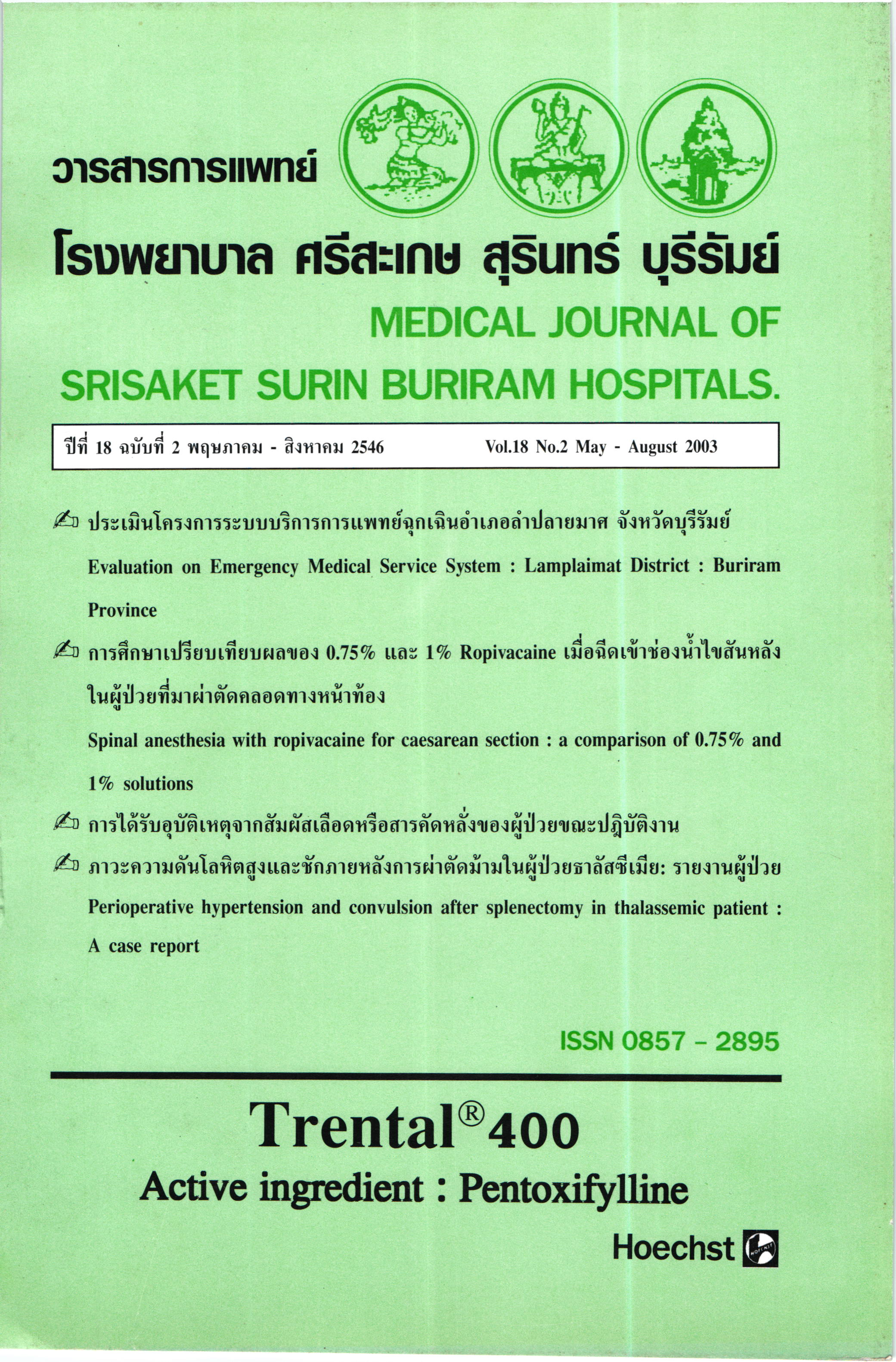การได้รับอุบัติเหตุจากสัมผัสเลือดหรือสารคัดหลั่ง ของผู้ป่วยขณะปฏิบัติงาน
Main Article Content
บทคัดย่อ
บทนำ
เชื้อโรคที่ติดต่อทางเลือดและสิงคัดหลั่ง ทำให้เกิดอันตรายต่อบุคลากรทางการแพทย์ในระหว่างการปฏิบัติงาน โดยเฉพาะเมื่อมีการกระจายของเชื้อเอชไอวีในยุคนี้จึงเป็นสิ่งที่เป็น ปัญหาอย่างมาก ถึงแม้จะมีเชื้อโรคกว่า 20 ชนิดที่ติดต่อทางเลือด (Blastomycosis, Brucellosis, Cryptococcosis, Diphtheria, Ebola virus .Hepatitis B, Hepatitis c, Herpes simplex HIV, Leptospirosis Malaria, Mycobacterium marinum, Mycoplasma caviae, Rocky Mountain spotted fever, Syphilis, Toxoplasmosis, Tuberculosis. Varicella zoster)11 แต่ทีสำคัญ คือตับอักเสบบี เชื้อเอชไอวี และตับอักเสบซี ชึ่งมีความเรื้อรังหรือรักษาไม่หาย ดังนั้นการมีแนวทางปฏิบัติในการป้องกันการเกิดอุบัติเหตุ และหลังจากได้รับอุบัติเหตุอย่างชัดเจนในสถานพยาบาลจึงเป็นสิ่งสำคัญ
Article Details
รูปแบบการอ้างอิง
คงสวัสดิ์ ว. (2019). การได้รับอุบัติเหตุจากสัมผัสเลือดหรือสารคัดหลั่ง ของผู้ป่วยขณะปฏิบัติงาน. วารสารการแพทย์โรงพยาบาลศรีสะเกษ สุรินทร์ บุรีรัมย์, 18(2), 29–38. สืบค้น จาก https://he02.tci-thaijo.org/index.php/MJSSBH/article/view/195903
ประเภทบทความ
บทความฟื้นฟูวิชาการ
เอกสารอ้างอิง
1. GM Varghese, OC Abraham and D Mathai ; Post-exposure prophylaxis for blood borne viral infections in healthcare workers. Postgrad Med Journal 2003;79:324-8
2. Gerberding JL, Occupational exposure to HIV in health care setting. N Eng J Med 2003;348;9:826-34.
3. อะเคื้อ อุณหเลฃกะ. การป้องกันการติดเชื้อเอชไอวีและเชื้อตับอักเสบปีในโรงพยาบาล. ใน อะเคื้อ อุณหเลขกะ; การติดเชื้อในโรงพยาบาล : ระบาดวิทยาและการป้องกัน : คณะพยาบาลศาสตร์ มหาวิทยาลัยเชียงใหม่. หน้า 118-54
4. Kelen, G.D. Considerations for Emergency Personnel. In DeVita, V.T., Heilman, S.& Rosenberg, S.A. AIDS: Etiology, Diagnosis, Treatment and Prevention. (3rd rd.). Philadelphia : J.B. Lippincott; 1992. p. 543-550.
5. Adegboye, AA., Moss, G.B., Soyinka., F&Kreiss, J.K. The Epidemiology of Needlestick and Sharp Instrument Accidents in Nigerian Hospital. Infect Control Hosp Epidemiol 1994;15:27-31.
6. Hersey, J.C.&Martin, L.S. Use of Infection Control Guidelines by Workers in Health care Facilities to Prevent Occupational Transmission of HBV and HIV : Result from a National survey. Infect Control Hosp Epidemiol 1994:15 (4):243-252
7. Pungpapong S, Phanuphak p, Pungpapong K, Ruxrungtham K. The risk of occupational HIV exposure among Thai healthcare workers. Department of Medicine, Faculty of Medicine, Chulalongkorn University. Southeast Asian J Trop Med Public Health. 1999 Sep;30 (3):496-503.
8. Center for Disease Control and Prevention. (2001). Surveillance of Health Care Personnel with HIV/AIDS As of December 2001. http://www.cdc.gov/nchstp/hiv-aids/pubs/facts/hcwsurv.htm
9. วันล่า กุลวิชิต. การดูแลรักษาบุคลากรทางการแพทย์ที่สัมผัสเลือดหรือbody fluid. ใน : วิทยา ศรีดามา (บรรณาธิการ) อายุรศาสตร์ฉุกเฉิน กรุงเทพฯ : ภาควิชาอายุรศาสตร์ คณะแพทยศาสตร์ จุฬาลงกรณ์มหาวิทยาลัย : หน้า161-74
10. Centers for Disease Control and Prevention. Updated US Public Health Service Guidelines for the management of occupational exposures to HBV, HCV, and HIV and recommendations for postexposure prophylaxis. MMWR Recomm Rep. 2001 Jun 29;50(RR-11):1-52.
11. Beekman, S.E., Fahey, B.J. & et al. Risky business: using necessarily imprecise casualty Counts to estimate occupational risks for HIV-1 infection. Infect Control Hosp Epidemiol 1990:11:371-379
12. Centers for Disease Control and Prevention. Guidelines for prevention of transmission of HIV and HBV to health care and public safety workers. MMWR Morb Mortal Wkly Rep 1989;38:3-37.
2. Gerberding JL, Occupational exposure to HIV in health care setting. N Eng J Med 2003;348;9:826-34.
3. อะเคื้อ อุณหเลฃกะ. การป้องกันการติดเชื้อเอชไอวีและเชื้อตับอักเสบปีในโรงพยาบาล. ใน อะเคื้อ อุณหเลขกะ; การติดเชื้อในโรงพยาบาล : ระบาดวิทยาและการป้องกัน : คณะพยาบาลศาสตร์ มหาวิทยาลัยเชียงใหม่. หน้า 118-54
4. Kelen, G.D. Considerations for Emergency Personnel. In DeVita, V.T., Heilman, S.& Rosenberg, S.A. AIDS: Etiology, Diagnosis, Treatment and Prevention. (3rd rd.). Philadelphia : J.B. Lippincott; 1992. p. 543-550.
5. Adegboye, AA., Moss, G.B., Soyinka., F&Kreiss, J.K. The Epidemiology of Needlestick and Sharp Instrument Accidents in Nigerian Hospital. Infect Control Hosp Epidemiol 1994;15:27-31.
6. Hersey, J.C.&Martin, L.S. Use of Infection Control Guidelines by Workers in Health care Facilities to Prevent Occupational Transmission of HBV and HIV : Result from a National survey. Infect Control Hosp Epidemiol 1994:15 (4):243-252
7. Pungpapong S, Phanuphak p, Pungpapong K, Ruxrungtham K. The risk of occupational HIV exposure among Thai healthcare workers. Department of Medicine, Faculty of Medicine, Chulalongkorn University. Southeast Asian J Trop Med Public Health. 1999 Sep;30 (3):496-503.
8. Center for Disease Control and Prevention. (2001). Surveillance of Health Care Personnel with HIV/AIDS As of December 2001. http://www.cdc.gov/nchstp/hiv-aids/pubs/facts/hcwsurv.htm
9. วันล่า กุลวิชิต. การดูแลรักษาบุคลากรทางการแพทย์ที่สัมผัสเลือดหรือbody fluid. ใน : วิทยา ศรีดามา (บรรณาธิการ) อายุรศาสตร์ฉุกเฉิน กรุงเทพฯ : ภาควิชาอายุรศาสตร์ คณะแพทยศาสตร์ จุฬาลงกรณ์มหาวิทยาลัย : หน้า161-74
10. Centers for Disease Control and Prevention. Updated US Public Health Service Guidelines for the management of occupational exposures to HBV, HCV, and HIV and recommendations for postexposure prophylaxis. MMWR Recomm Rep. 2001 Jun 29;50(RR-11):1-52.
11. Beekman, S.E., Fahey, B.J. & et al. Risky business: using necessarily imprecise casualty Counts to estimate occupational risks for HIV-1 infection. Infect Control Hosp Epidemiol 1990:11:371-379
12. Centers for Disease Control and Prevention. Guidelines for prevention of transmission of HIV and HBV to health care and public safety workers. MMWR Morb Mortal Wkly Rep 1989;38:3-37.


